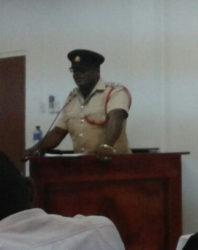The sole Fire Service Investigator to assess the scene of the Camp Street prison fire has concluded what was already established by numerous accounts so far—that the fatal fire was started by inmates belonging to the Capital A Division although who is specifically responsible is yet to be determined.
The investigator, Andrew Holder, who has 18 years’ experience in the Fire Service, yesterday told the members of the Commission of Inquiry (CoI) probing the tragedy that it was his role to merely determine the cause of the fire, and the police’s job to determine who started it. His assessment was dependent on interviews conducted with six inmates, whose identities were protected during the proceedings yesterday for security reasons. He also relied on the corroboration of witness statements with “data from the physical assessment of the structure,” and the principles of fire engineering.
Holder’s initial observations indicated that there were two seats of fire; one at the back door and the other near the hole in the wall dividing the Capital A and B divisions. It was later determined that the fire near the door had actually been lit on the first night of the unrest, March 2nd.

He found that a mattress or mattresses had been set on fire by an inmate or multiple inmates. Like Fire Chief Marlon Gentle, he concluded that a flashover had occurred, where the chemicals from the burnt material had become so heated that they would have automatically ignited other mattresses, timber, clothing and human beings.
He said that unless interrupted (by extinguishing), this fire would burn violently until all the fuel, meaning anything ignitable, was consumed. His investigations determined that most of this fuel was located at the front of the division, where the majority of the bodies were found. In the case of Capital A, 80% to 90% of the content in the room had been engulfed. Seventeen inmates died in the fire.
Holder did not interview all the survivors of the fire, as, according to him, he found that all the inmates’ accounts of the origin seemed to be the same. He reported that one prisoner related to him that he found out the name of the fire starter after conducting his own investigations, but the name of that suspected inmate was not divulged at the hearing although it is stated in the final report.
He said he had asked another inmate whether there had been any feuds among the prisoners before the fire, but was told that everything was normal. That prisoner, however, later admitted that an inmate, also known but not named, was overheard relating to other inmates that he, along with his cousin, “jook up somebody” in the Capital A Division. That prisoner stated, however, that he had been there the entire time and did not see anything of the sort occur. This new claim may have major implications, given a report by Gentle on Thursday that two of the bodies discovered at the crime scene had wounds inconsistent with fire injuries.
Holder admitted to Guyana Bar Association attorney Glen Hanoman that no physical evidence had been collected during the analysis, as there had been no ambiguities in determining the cause of the fire. However, previous witness testimonies have indicated that tear gas was thrown into the dorm by officers after a smaller fire had been extinguished, following which an explosion occurred. According to Holder, however, no tear gas canisters had been retrieved at the scene.
When questioned by Hanoman as to whether tear gas could contribute to fire, Holder explained that that was not within his field of expertise, and later, under re-examination by Joint Services attorney Eusi Anderson, he stated that the effects of tear gas usually linger, but none were felt by him when he entered the dorm soon after the fire was extinguished.
Later though, under cross-examination by Commission Counsel Excellence Dazzell, he reasoned that tear smoke, like fire, both act to deplete oxygen in the air. It could therefore be deduced that had the initial fire not been completely extinguished when the canister was thrown, and had the fire been large enough, the tear gas could have accelerated the rate at which the fire spread.
Also appearing before the tribunal yesterday was Superintendent of Police Khali Pareshram, who indicated that investigations were conducted by police ranks from the Divisional Detective Unit. In response to Hanoman’s probing about the use and accountability of joint services equipment such as tear gas, he stated that records would reflect if any were used.





